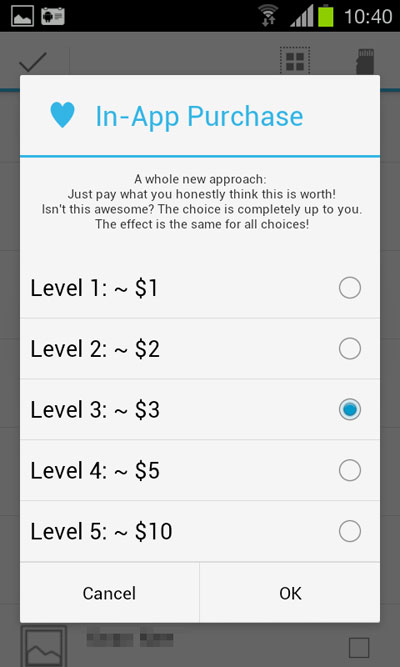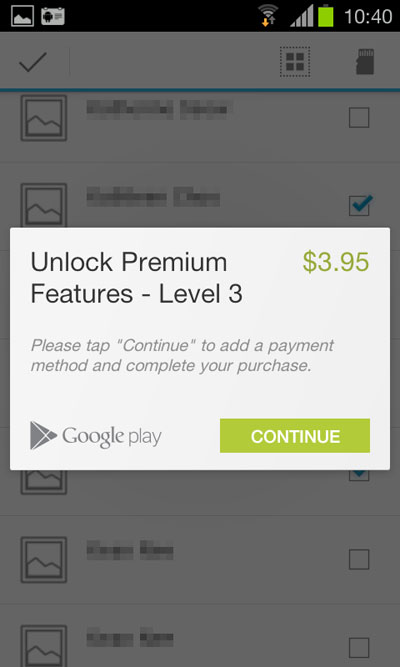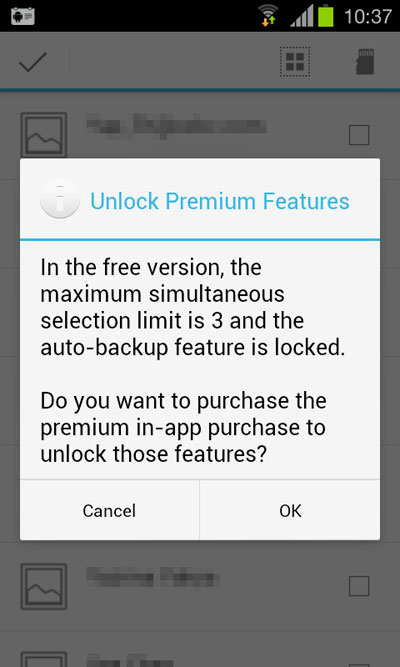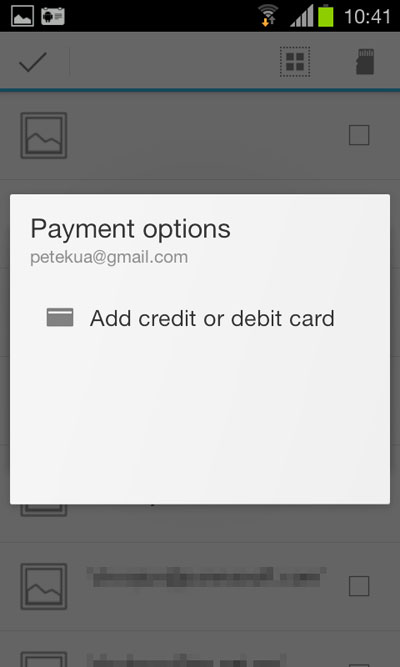The Android app, Easy Contact Sync, is a contact backup tool that allows you to back up your phone contacts to its SD card and a range of cloud-based storage. This app has a Pay-What-You-Want (PWYW) in-app purchase as shown in the following series of images (courtesy of Paradise Android):
Figure 1: In-app purchase dialog box pops up when the user selects more than three contacts to copy.
 Figure 2: Pay the price you think is worthy of the app. Or, pay what you can afford. Whatever price you choose to pay, you will get the same product.
Figure 2: Pay the price you think is worthy of the app. Or, pay what you can afford. Whatever price you choose to pay, you will get the same product.
 Figure 3: Confirm the price you want to pay.
Figure 3: Confirm the price you want to pay.
Figure 4: Pay, or add your credit/debit card details.
In-App Purchase PWYW can yield a higher number of purchases because the buyer is free to pay what he feels the app is worth. If he finds the app superb, he may be pleased to fork out a higher price for the in-app product. If your app isn’t very delightful, but still useful, he may still go ahead with the in-app purchase, but at a reduced price.
With in-app PWYW, the buyer is now permitted to pay what she can afford. This eliminates alienating the potential buyer who loves your app but feels she cannot afford the fixed-price in-app purchase. With PWYW in-app purchases, the developer will still receive money from this type of buyers, though the amount is diminished. Click here.
The buyer may think your app is great, or the buyer may feel your app is passable. She may be able to easily afford the app, or she may not have much money. To get cash immediately for the app, look for loanload.co.uk on the internet and fill up their application. But with PWYW in-app products, suddenly all these different types of buyers are able to pay the amount they feel is right. Because of this, the number of purchases for a PWYW in-app product is proven to be much higher compared to that of a fixed-price in-app product.
In-App Purchase PWYW can result in higher profits if you donate part of the proceeds to charity. In one PWYW research, they found consumers willing to pay up to five times more if a portion of the revenues was given to charity. In another PWYW study, the average price paid for an item was initially $0.92. Then, when consumers were told that half the proceeds would go to aid organizations, the average price paid for the item jumped to a staggering $6.50.
Suggest a reasonable price. To encourage your app users to pay more than the minimum price set for your in-app product, you can suggest a “reasonable” price. For example, if you have the pricing options like in Figure 2 above, you can preselect the $3 option if you feel that’s the reasonable price for your in-app product.
Play with your buyer’s ego. Tell the buyer that on average, users paid X dollars for your in-app product. This average price ties in with the preselected “reasonable” price where both these prices should not be far apart. You want the buyer to feel the peer pressure of not wanting to be a scrooge and, on their purchase, match the average price or better it, for the sake of massaging their own ego.
Give PWYW a try in your in-app purchase and tell me how well it works for you.
References:
http://en.wikipedia.org/wiki/Pay_what_you_want
http://sandiego.bbb.org/article/is-there-a-pay-what-you-want-payoff-41247


